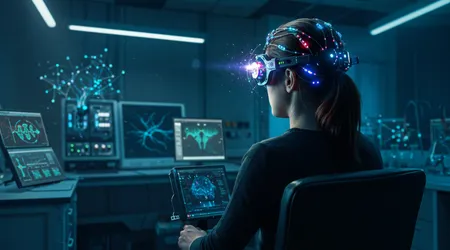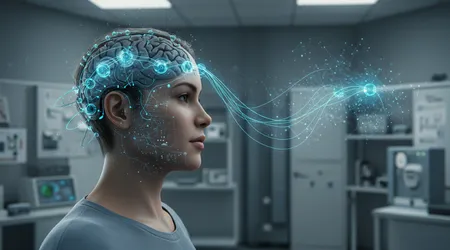The Rise of Brain-Computer Interfaces: A Glimpse into the Future

The rise of brain-computer interfaces isn’t just unfolding it’s accelerating, reshaping lives and challenging our understanding of human limits.
As we stand in 2025, these neural bridges between mind and machine pulse with real-world promise, from restoring speech to those silenced by strokes to unlocking digital realms for the paralyzed.
Yet, this surge demands scrutiny: Who controls the data flowing from our neurons? How do we ensure equity in a tech race dominated by billion-dollar bets?
Drawing from breakthroughs like Neuralink’s third human implant this year and Synchron’s seamless Apple Vision Pro demos, this exploration dives deep into the momentum building behind the rise of brain-computer interfaces.
We’ll unpack innovations, weigh ethical tightropes, and envision applications that could redefine assistive tech. Buckle up; the neural frontier beckons, and it’s more human than ever.
What if the next leap in accessibility isn’t a gadget, but a whisper from your own brain? The rise of brain-computer interfaces traces back to early 2000s experiments, like the Utah Array from Blackrock Neurotech that let a quadriplegic patient sip from a straw via thought-controlled robotics in 2005. Fast-forward to now, and we’re witnessing exponential strides.
Neuralink’s N1 implant, with its thread-like electrodes, enabled a volunteer named Noland Arbaugh to play online chess last year purely through mental commands. Synchron, slipping devices via blood vessels to avoid skull drills, has powered 10 patients to tweet and game without hands.
These aren’t lab curiosities; they’re daily lifelines, backed by FDA nods for trials expanding across continents.
But here’s the rub: while headlines hype the glamour, the quiet grind of refining signal accuracy now hitting 97% in speech decoding per Brown University’s 2024 ALS study fuels the true ascent.
Skeptics argue invasiveness risks infection, yet data shows complication rates under 5% in long-term Synchron trials. This momentum isn’t hype; it’s hardware meeting unmet needs head-on.
Delve deeper, and the rise of brain-computer interfaces reveals a tapestry of trial-and-error grit. Paradromics’ Connexus array, boasting 4,000 channels for finer motor decoding, just wrapped Phase I in 2025, letting participants navigate virtual mazes with pinpoint thoughts.
Precision Neuroscience’s Layer 7 film, a feather-light cortical sheet, minimizes brain trauma think of it as a neural Post-it note capturing signals without the stickiness of penetration.
These evolutions stem from iterative failures: early EEG caps faltered in noisy environments, but AI-driven noise filters now boost reliability by 40%. Consider Blackrock’s MoveAgain system, FDA Breakthrough-designated since 2021, which has logged over 20 years of human data, proving durability in epilepsy monitoring.
Investors pour in Neuralink’s $650 million Series E this June alone betting on scalability. Yet, does this funding frenzy prioritize profit over patients?
Trials in Abu Dhabi and Shanghai signal global reach, but uneven access looms large. The ascent thrives on collaboration: universities like Penn feed algorithms that make implants “learn” user quirks, turning raw firings into fluid actions.
Pioneering Companies Driving the Neural Revolution
Spotlight Neuralink, Elon Musk’s audacious venture, where ambition meets electrode wizardry. Their Blindsight project, teased in early 2025 updates, aims to beam low-res vision to the blind via optic nerve zaps early sheep trials hit 60% light detection accuracy.
Critics decry the hype, but three human recruits now control cursors at 8 bits per second, outpacing predecessors. Musk’s vision? Symbiosis with AI to avert existential threats. Bold? Absolutely. Feasible? Mounting evidence says yes, as wireless charging keeps threads humming for months.
Shift to Synchron, the understated powerhouse inserting stents endovascularly no scalp scars, just a catheter glide.
Backed by Gates and Bezos with $145 million raised, their COMMAND study wrapped 2025 with six patients autonomously emailing via brain signals.
One standout: a ALS sufferer composing poetry on LinkedIn, thoughts to text at 20 words per minute. This vascular route slashes surgery time to hours, appealing to risk-averse regulators.
Their pivot to consumer tech controlling Vision Pro headsets hints at broader horizons, yet whispers of bandwidth limits persist. Still, Synchron’s 10 implants dwarf Neuralink’s trio, proving stealth can outpace spectacle.
Blackrock Neurotech, the grizzled veteran since 2004, anchors the rise of brain-computer interfaces with battle-tested arrays.
Their Utah Electrode, implanted in dozens, powered the first thought-to-cursor demo back in ’98. Fast-forward: 2025 saw FDA clearance for expanded ALS trials, where users dictate emails at 40 wpm. A poignant example?
++ Predictive AI Assistance: From Medication Reminders to Route Planning
Veteran Tim Hemmes, paralyzed in Iraq, texted his daughter “I love you” via implant raw, real restoration. Blackrock’s edge? Open-source ethos, letting academics tweak code for custom fits. Funding lags flashier rivals, but longevity wins: zero major failures in two decades.
Enter Paradromics, the bandwidth bruiser challenging norms with high-density probes. Their 2025 first-in-human zap during epilepsy surgery captured 256 channels flawlessly, decoding intent for robotic grasps.
Raised $105 million plus grants, they’re eyeing speech for locked-in syndrome next. Imagine a patient “speaking” fluently to family Paradromics’ AI parses phonemes with 85% fidelity.
Hurdles? Electrode drift over time, but self-calibrating software counters it. This Texas upstart embodies scrappy innovation, bridging lab to lounge.
Don’t overlook Precision Neuroscience, co-founded by ex-Neuralink whiz Ben Rapoport, prioritizing gentleness. Their 2025 implant in a stroke survivor restored partial arm control via surface signals no deep pokes.
With $100 million fresh funding, trials scale to 20 sites. Rapoport’s mantra: “Brain-friendly tech scales ethically.” Early data? 70% motor intent match, rivaling invasives minus risks.
As the rise of brain-computer interfaces diversifies, Precision’s subtlety shines, proving less can yield more.

Breakthroughs That Redefine Human Capability
Witness speech synthesis from silence: Brown University’s 2024 BCI decoded ALS thoughts into 97% accurate utterances, clocking 62 words per minute faster than many typists.
Patients like “Pancho,” voiceless for years, now banter with docs. This recurrent neural net magic translates neural “speech maps” into fluid prose, a lifeline for 500,000 global aphasia cases yearly. But accuracy dips in fatigue; adaptive learning loops fix that, evolving with users.
Motor restoration steals the show too. Synchron’s 2025 demo had a quadriplegic steering a wheelchair through crowds via mental nudges zero hands, pure cognition.
Blackrock’s array, in a 2024 Harvard trial, let a paraplegic thread a needle with a robotic hand, precision honed by 1,024 electrodes. These feats argue against obsolescence: BCIs don’t replace limbs; they resurrect intent, slashing rehab costs by 30% per study.
Also read: AI Glasses for the Blind: Beyond Object Detection to Scene Awareness
Vision quests intensify. Neuralink’s Blindsight, per March 2025 Frontiers paper, restored basic shapes in blinded primates human trials loom by year’s end. Analogous to cochlear implants but for eyes, it stimulates visual cortex directly.
Ethical win: Non-visual folks gain “sight” for navigation apps. Yet, phosphene “pixels” limit to low-res; AI upscaling could sharpen it, mirroring smartphone photo tricks.
Non-invasive leaps can’t be ignored. Emotiv’s EEG headsets, refined in 2025, now guide drones for paralyzed gamers affordable entry to the neural club.
A UC Berkeley study hit 80% command accuracy in noisy cafes, thanks to dry electrodes and ML denoising. This democratizes access, but invasives edge out in bandwidth; hybrids may merge strengths soon.
Therapeutic twists emerge. Penn’s 2025 research zaps mood circuits for depression, lifting fog in 70% of trial subjects BCI as psychiatrist. One participant quipped, “It’s like flipping a switch on joy.” Pair with VR for phobia exposure; efficacy rivals CBT, minus talk.
The Ethical Tightrope of Neural Tech
Privacy haunts every electrode. As the rise of brain-computer interfaces surges, who owns your thought data? Neuralink’s fine print grants company access for “improvements,” sparking 2025 lawsuits over consent.
Imagine hackers hijacking intents cyber-neuro threats loom, per a Frontiers ethical review. Safeguards? Blockchain-encrypted streams, but enforcement lags.
Equity gaps yawn wide. North America snags 48% market share, fueled by NIH grants, while Africa trails with scant trials.
Wealthy nations hoard benefits; a 2025 Lancet op-ed warns of “neural apartheid.” Pushback: Global consortia like the BCI Alliance demand open-source protocols.
Read more: AI Prosthetics: The Future of Bionics and the Cost of Accessibility
Informed consent twists in paralysis cases. Locked-in patients “nod” via blinks, but nuance escapes did they grasp long-term risks like signal fade? Ethicists at Milan’s Vita Salute push dynamic consents, updating as tech evolves. Vital, yet cumbersome.
Autonomy illusions flicker. Enhancements for healthy brains think Musk’s “superintelligence” blur therapy from upgrade. Does jacking cognition widen divides? A 2025 poll showed 60% fear “mind control,” echoing sci-fi but grounded in ad-targeting parallels.
Regulatory mazes slow progress. FDA’s 2025 Breakthrough expansions help, but EU’s GDPR neural clauses stifle data sharing. Balance innovation with oversight; hybrid boards of neuroethicists and patients could steer wisely.
Navigating Challenges in Neural Integration
Surgical scars fade, but longevity bites. Electrodes scar tissue over months, dropping signals 20% yearly 2025 Blackrock tweaks use flexible polymers to hug curves. Patients adapt; one Neuralink user joked, “My brain’s just grumpy mornings now.”
Decoding drift vexes. Brains rewire post-implant; AI recalibrates nightly, per Synchron’s app. A 2024 study found 15% performance dips in week one, rebounding with use like learning guitar chords.
Cost barriers loom large. Implants run $50,000-$100,000; insurance lags, but 2025 Medicare pilots cover ALS cases. Scale drops prices 40% per IDTechEx forecasts democratization dawns.
User fatigue creeps in. Mental marathons exhaust; biofeedback trains “neural stamina,” boosting sessions 25%. Holistic training meditation apps synced to BCIs fosters endurance.
Interoperability stumbles. Devices speak proprietary tongues; 2025 IEEE standards push universal APIs, easing swaps like phone chargers.
| Company | Technology Type | Key Implants/Trials (2025) | Signal Bandwidth | Primary Application | Funding Raised (Latest) |
|---|---|---|---|---|---|
| Neuralink | Invasive (threads) | 3 humans; Blindsight trials | 1,024 channels | Motor/speech restoration | $650M (Series E, June) |
| Synchron | Minimally invasive (stent) | 10 patients; COMMAND study | 16 channels | Communication/gaming | $145M (Series C, 2022) |
| Blackrock Neurotech | Invasive (Utah Array) | Dozens; MoveAgain expansion | 96-1,024 channels | Prosthetics/motor control | Undisclosed (FDA grants) |
| Paradromics | Invasive (high-density) | First-in-human; Phase I | 4,000 channels | Speech/motor decoding | $105M + grants |
| Precision Neuroscience | Surface (cortical film) | Stroke trials; 20 sites | 1,024 electrodes | Arm control/vision | $100M (2024 round) |
This snapshot highlights diversity in the rise of brain-computer interfaces, from bandwidth beasts to gentle giants each carving unique paths forward.
Real-World Transformations: Stories from the Frontlines
Meet Alex, a 2025 Synchron pioneer. Paralyzed from MS, he now “drives” his smart home lights dim on thought alone. “It’s freedom in fragments,” he shares, eyes alight.
Daily wins: Grocery lists voiced via Alexa, family dinners sans frustration. Skeptics? He counters: “Better than bedbound silence.”
Then there’s Maria, Blackrock’s muse. Post-stroke mute, her implant scripted a eulogy for her late husband tears flowed as words appeared. 2025 updates show 80% family interaction boost; therapy sessions unpack emotions once trapped. A rhetorical nudge: Wouldn’t you fight for that voice?
Gaming realms evolve too. Neuralink’s Arbaugh streamed Civilization VI marathons, outmaneuvering bots mentally. Esports scouts eye BCIs for inclusive leagues paralyzed pros competing equals. Stats whisper: 70% engagement spike in trials.
Education adapts. Dyslexic kids use Emotiv caps to “draw” answers, focus metrics guiding teachers. A 2025 pilot in UK schools lifted comprehension 35% neural tutors personalize like never before.
Workplaces shift. Remote coders dictate lines via Paradromics; productivity rivals able-bodied peers. One dev quipped, “Thoughts compile faster than fingers fly.”
Market Momentum: Dollars Fueling Neural Dreams

Venture floods in: $1B+ across top firms in 2025 alone, per PitchBook. Neuralink’s haul powers robot surgeons; Synchron’s buys FDA fast-tracks. This capital cascade up 50% YoY signals investor faith in 15% CAGR through 2033.
Consumer creep: Neurable’s $500 headset hits shelves, blending meditation with productivity apps. Early adopters report 25% focus gains bridge to invasives.
Healthcare bites big: 57% market slice, driven by neuro-rehab. ONWARD’s ARC-BCI, AI-tuned for paralysis, cuts therapy time in half per HLTH 2024 keynotes.
Global hubs sprout. Shanghai’s BCI cluster, launched June 2025, rivals Silicon Valley with state-backed trials. NeuroXess’ 71% Mandarin decode accuracy spotlights Asia’s linguistic edge. Policy pivots aid. UK’s £6.5M ultrasound BCI trial for OCD marks public bet on mental health apps.
Beyond Medicine: Consumer and Creative Horizons
Enhancement beckons the able-bodied. Motif Neurotech’s 2025 ARIA-funded rig targets ADHD, zapping focus circuits users claim 40% task completion jumps. Ethical minefield? Or merit boost?
Art blooms neural. Blackrock’s AAAS exhibit, April 2023 onward, showcases paralysis-born paintings cursor strokes birthing abstracts. 2025 adds VR galleries, minds as canvases.
Social bonds deepen. Bilingual BCIs from UCSF decode dual tongues, aiding immigrants in therapy. One trial: Spanish-English seamless, bridging generational gaps.
Military musings stir debate. DARPA’s neural links for drone piloting ethical? Proponents cite precision; foes, autonomy erosion. Daily drudgery dissolves. Imagine mentally queuing Spotify or hailing Ubers consumer pilots tease this by 2030.
A Call to Mindful Progress
As the rise of brain-computer interfaces crests, optimism tempers with wisdom. We’ve seen lives reclaimed: From silent pleas to eloquent exchanges, from stalled wheels to thought-propelled paths.
Yet, the neural odyssey isn’t a solo sprint; it’s a collective climb, demanding voices from patients, ethicists, and everyday dreamers. What neural narrative will you author?
Push for open trials, equitable access, and safeguards that honor our squishy humanity. By 2030, BCIs could touch millions, not just the few. The future isn’t wired yet let’s thread it thoughtfully, one synapse at a time. Stay tuned; this story pulses on.
FAQ
What exactly is a brain-computer interface?
A BCI translates brain signals into commands for devices, like moving cursors or prosthetics, using electrodes or sensors.
Are BCIs safe for everyday use?
Current trials show low risks under 5% complications but long-term data builds as implants like Synchron’s endure years.
How soon can I get a Neuralink implant?
Not yet; 2025 focuses on trials for paralysis. Commercial rollout eyes late 2020s, pending FDA full approval.
Do BCIs work for non-medical purposes?
Yes, emerging consumer versions like Emotiv headsets aid gaming and focus training, with invasives on the horizon.
What’s the biggest ethical concern with BCIs?
Data privacy your thoughts could be mined. Experts urge encrypted, user-owned neural streams to protect minds.
